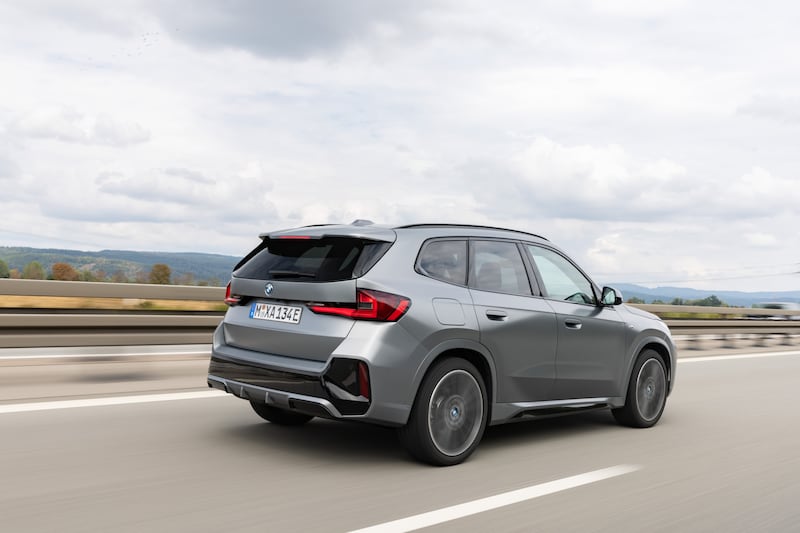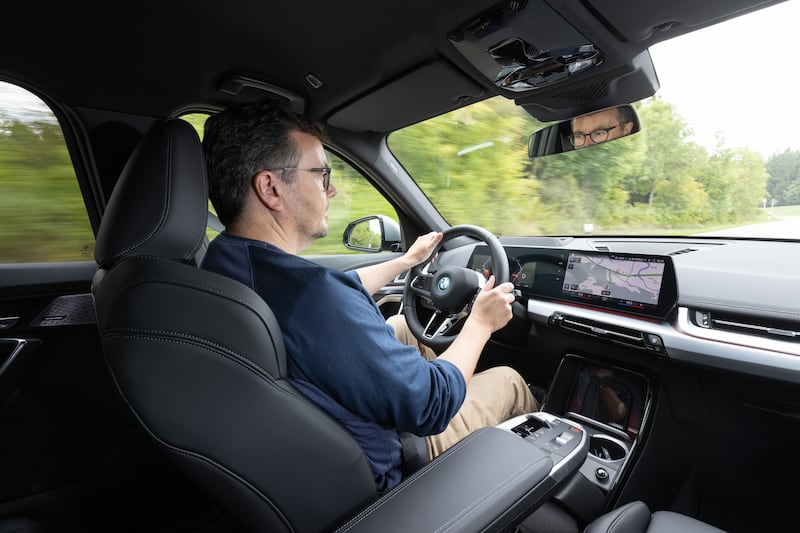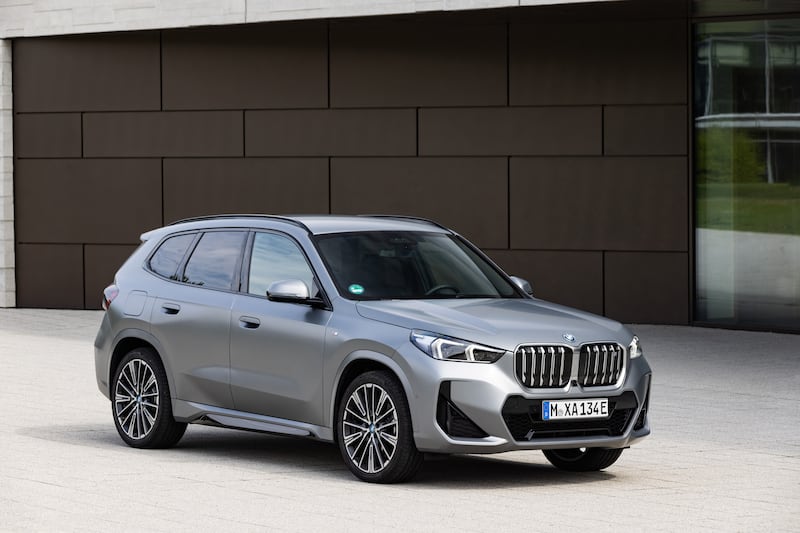If our Merrion Street financial masters need any further evidence of the impact of inflation, they need only look at any premium car price list.
Long gone are the days when you could pick up a BMW 520d SE automatic with leather trim – the go-to premium car for Celtic Tiger cubs – for €45,000. Now that’s the price you pay for a Kia Sportage plug-in hybrid.
At BMW, the latest upgraded version of the smaller 3 Series starts at €52,440 for the 320i. Premium car retailers must be praying that claims the “rich are getting richer” are true or their sales are going to take a hit.
Of course, you can’t really judge the generations of a car simply on price. Take this new X1, BMW’s entry-level SUV. The differences between the X1 of its launch year in 2009 and the current generation are significant. For a start, this looks and feels like a far more substantial SUV.
RM Block
If you want evidence of the motoring growth spurt in the metal, look at the new BMW X1 parked nose-to-nose beside its supposedly bigger brother, the current X3.
And it’s not just in terms of its exterior. When it was first launched back in 2009, the X1 was regarded as a solid entry-level crossover, but tight in terms of rear-seat legroom. Now in its third generation, the latest X1 has most of the family functionality of an X3, including in the rear seats.
Then there’s the tech. BMW’s latest cars are connected in ways that seemed unimaginable just a decade ago
Which is good, because the massive leap in new car prices in the past few years means that the X3 range now starts at an eye-watering €70,595. There must be many X3 owners now considering the latest X1 for their motoring needs.
Then there’s the tech. BMW’s latest cars are connected in ways that seemed unimaginable just a decade ago. Just a few examples: the new X1 includes cloud-based maps, 5G connectivity, and an interior camera that makes it possible to remotely see inside the car via a smartphone app.
Yet it hasn’t lost its characteristic kidney-grille look along the way. More than enough ink has been expended on BMW’s recent contentious design language, the big grilles and the multiple creases that end aimlessly halfway down a door.
Frozen grey
Thankfully, the new X1 range is a far more traditional BMW proposition, with the benefit of some gorgeous new colour options, including a great looking frozen grey. With this latest generation, the designers have delivered a more squared-off design, giving it more road presence and putting some clear water between it and the closely related X2.
The front grille is big, but it’s as nothing compared to those adorning BMW’s gargantuan X7 or the mouthy IX.

Proportionally BMW has got the new X1 just right. While it’s meant to be a rival for premium compact SUV models such as the Volvo XC40 and Mercedes GLA, its height of 1,642mm is on a par with larger models such as the Mercedes-Benz GLC.
That extra bulk is reflected inside as well, with decent rear-seat legroom and boot space, increased by 50 litres over the outgoing model to 540 litres and 1,600 litres on regular combustion engine versions.
The system harvests kinetic energy under braking to charge a small battery that in turn powers an 19bhp electric motor that lets the regular engine disengage when the car is coasting
The interior layout takes its cue from the larger all-electric iX, with dual digital screens stretching across the dash, wireless Apple CarPlay and Android Auto connections, a smart holder for your phone and the floating centre armrest with toggle transmission control and the ability to choose from a variety of driving modes. Some of the plastics on that central console could deliver a more premium finish but it’s the tidiest interior BMW has created in several years.
On its digital touchscreen system, BMW still has an apps problem. The clutter of pointless apps and multiple menus is neither intuitive nor user-friendly and someone in Munich is going to have to hit reset and come up with a better way to offer up the functionality and cut out all the useless frippery.

Regular powered X1s start with the sDrive 18d, a front-wheel-drive set-up powered by a 150hp 2-litre four-cylinder diesel engine matched with a seven-speed dual-clutch auto transmission. There’s also a 197hp version of this engine in the 23d, which boasts BMW’s new 48v mild hybrid technology. The system harvests kinetic energy under braking to charge a small battery that in turn powers an 19bhp electric motor that lets the regular engine disengage when the car is coasting.
This mild hybrid tech is also fitted to the petrol version of the X1 going on sale here, the xDrive 23i, priced at €62,210.
For those who are eager to introduce a plug to their motoring life – but aren’t ready to make the big leap to full electric – there are also two PHEV versions on offer. These claim either 88km or 92km of all-electric range courtesy of a 16.4kWh battery pack, before turning to their 1.5-litre petrol engines for power.
Real star
However, the all-electric iX1 (or iX1 xDrive 30 to give it its full title) is the real star of the new X1 line-up.
Promising a range of 438km on a single charge of its battery pack, with a useable power of 64.7kWh, the new iX1 arrives in Ireland at €63,995.
It’s not just overall range that impresses with the new iX1. BMW is claiming this crossover will use as little as 17.2kWh/100km.
In terms of functionality, the EV set-up does reduce the boot space to 490 litres and 1,495 litres on both the iX1 and PHEV versions, but many will consider it’s worth the trade-off.
The iX1 gets a two-motor, four-wheel-drive system that produces an impressive 313hp in what is billed as “Boost” mode. It also gets BMW’s adaptive suspension system as standard.
Like all EVs, the iX1 crossover is technically capable of delivering a tidal wave of torque and acceleration, but its engineers must make it driveable on average roads.
The idea of a Boost lever and a countdown clock that pops into the heads-up display may be taken from the realm of computer games, but it’s no marketing gimmick. Hit that lever and hold on
The varied approaches to dialling down the electric surge is becoming a differentiator between EV models and brands. With the iX1, BMW has got the balance about right, with an impressive 5.6 seconds time from 0-100km/h, and the capability to call up the Boost function for up to 10 seconds that delivers a more Fast and Furious pace.
Operated via a paddle on the steering wheel, it basically calls up Sports mode for a short spurt, without having to fiddle through the multiple settings menus.
The idea of a Boost lever and a countdown clock that pops into the heads-up display may originate in the realm of computer games, but it’s no marketing gimmick. Hit that lever and hold on.
Refined commuter
It can make the handling a little lumpy, with hints of the sort of torque steer commonly encountered in early versions of BMW’s all-electric i3. But for overtaking manoeuvres or quickly getting out of trouble, it more than proves its worth.
It’s a smart way for owners to get the benefits of Sports mode settings when it’s needed, and spend the rest of the time with the iX1 as a properly refined commuter.

Overall, the iX1 and X1 versions we drove showcased a crossover SUV set-up that is happy on both long-distance motorway runs and country roads.
Our test route mixed fast-paced autobahn sections with tight and twisting rural roads. On the long straights of an open road the X1 is a refined mile muncher, but pit it against scruffier back roads and this car can carry speed through a bend, nuzzle its front nose into the apex and come out the other side with pace. It’s not quite saloon car agility, but it’s certainly sharper than you get with most crossovers these days.
While we were impressed with the regular X1 versions, it’s the all-electric iX1 that will pique a lot of premium car buyer interest, combining EV power with SUV styling and decent five-seat family practicality.
It faces several challengers, particularly the likes of Audi’s Q4 E-tron, which is offered with three battery sizes from 55kW to 82kW and prices starting at €42,255, though supply seems to be an issue.
With the new X1, BMW has delivered a surprisingly spacious compact SUV that comes in a wide range of flavours, from petrol power to full EV. It delivers remarkable poise for such a sizeable car, particularly in its iX1 guise.
While we struggle to get our heads around the inflationary pricing for premium cars, it’s easy to see how current X3 owners could be tempted to move to a lower numeral. Certainly the iX1 has enough on offer to attract potential buyers from rival brands as well.



















